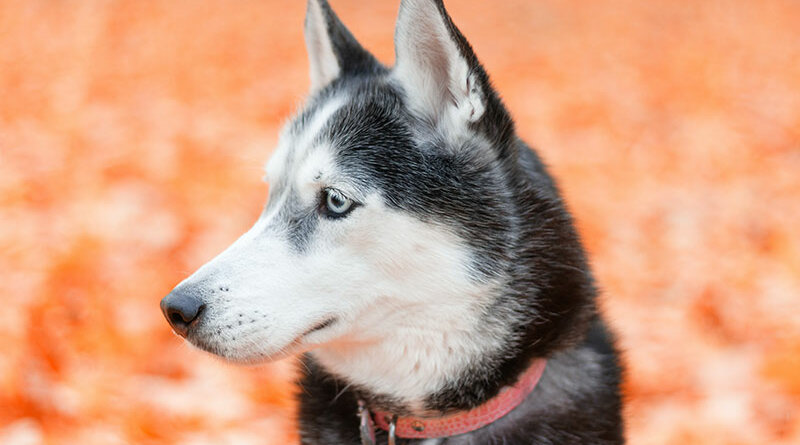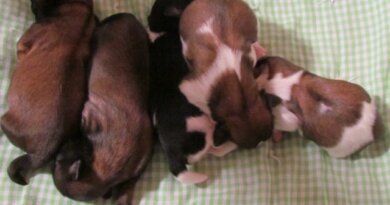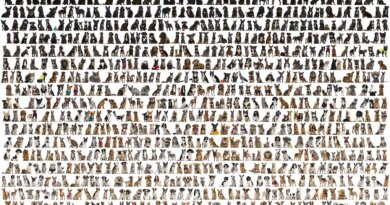Huskies—Dire Wolf Fans Create Glut of Abandoned Dogs
Shelters and rescue groups have seen dramatic increases in the number of homeless Huskies, Alaskan Malamutes and other wolfy-looking dogs coming through their doors. Inspired in part by a popular television series, people buy one of these fluffy puppies on impulse (often online) and find themselves in way over their heads. Here, we look at how media popularity has affected these dogs and provide a primer on what Huskies—the breed that’s been most dramatically affected—are and are not.
Originally, people living in the far north bred dogs to, among other things, pull heavily loaded sleds long distances across some of the world’s coldest landscapes. Today, these northern-breed dogs—Siberian Huskies, Alaskan Malamutes, Samoyeds, Akitas and other Spitz-type dogs—spend most of their time as companions in a world where pulling a sled for a living is pretty much never required.
In the past few years, the numbers of lost, abandoned or surrendered northern breeds—Huskies in particular—have been climbing. Ask anyone involved in sheltering or rescuing them why, and the answer you’re likely to hear is short and not sweet: Game of Thrones and its “dire wolves.” The canines who appeared in this American fantasy drama, which had an audience of more than 32 million viewers per episode during its eighth and last season in 2019, were Northern Inuit dogs, a type specifically created to resemble wolves by cross-breeding Siberian Huskies and German Shepherds.
Northern-breed rescue groups in both the U.S. and abroad began seeing an uptick in the numbers of dogs in need starting in 2011, the year Game of Thrones debuted. As the U.K.’s largest dog welfare charity, Dogs Trust, reported in 2019, “In 2010, a year before the first series aired, just 79 Alaskan Malamutes, Siberian Huskies and Akitas were cared for by Dogs Trust, compared to 411 last year—a 420 percent increase.”
GET THE BARK IN YOUR INBOX!
Sign up for our newsletter and stay in the know.
Dana Ramirez, of the nonprofit rescue and rehabilitation center, Rancho Luna Lobos, concurs. “I would say that media absolutely plays a huge role in Huskies ending up in shelters. We see this time and time again … someone buys a Husky and then wants to surrender them because they are too much work. We have a friend who breeds Seppala Huskies, and after the movie Togo came out, his puppy requests went through the roof.”
Unfortunately, Siberian Huskies aren’t the first breed feel the pain of popularity. Remember Lassie? Rin-Tin-Tin? Pongo, from 101 Dalmatians? Bruiser, the Chihuahua in Legally Blonde? Over the years, as the entertainment industry has fueled demand for particular types of dogs, puppy mills and backyard breeders have ramped up their efforts to meet it. (Reputable breeders spend a lot of time quizzing prospective buyers about their lifestyle and housing situation—doing their best to talk them out of getting a Husky unless they have a real commitment to the dog’s well-being.)
Realistically, most of us probably understand that buying a dog like one we love on the screen doesn’t mean the dog we get will act the same as a dog who’s been trained by pros. Yet sadly, it seems that the allure of living with our very own Pongo or Bruiser—or dire wolf—overrides that understanding far too often.
The phenomenon is so common that it attracted scientific attention. In their report on a 2014 study, Dog Movie Stars and Dog Breed Popularity: A Case Study in Media Influence on Choice, researchers concluded that “the release of movies featuring dogs is often associated with an increase in the popularity of featured breeds for up to 10 years after movie release.”
Here’s the bottom line: Unless you truly understand what Huskies need and are willing and able to provide it, don’t give in to the image, or the impulse. Without the exercise and stimulation they require, Huskies become frustrated and act out. If the owner doesn’t understand why that’s happening, the acting-out can lead to a one-way trip to the shelter, to being abandoned far from home, or worse.
Don’t be that person.
Husky Basics
For every generalization, there’s an exception—and often, several. With that in mind, here’s a short list of what you generally can and cannot expect from a Husky.
Six Things Huskies Are …
1. Working dogs. Smart, curious and easily bored, they need something to do. Without it, they’re likely to make up a job for themselves (digging, climbing and escaping are often involved).
2. Good-natured and affectionate. They like people and are always up for fun.
3. Hardwired to run. Inattentive humans, insecure fencing, open doors and open gates can have disastrous consequences.
4. Independent thinkers. This is another hardwired characteristic—bred to navigate with minimum human intervention, they’re inclined to make their own decisions.
5. Super-shedders. These double-coated dogs need to be brushed … frequently.
6. Vocal. Some people love their “call of the wild” howling, others, not so much.
Six Things Huskies Are Not …
1. Guard dogs. They’ll hold the door while thieves carry out your television and computer.
2. Couch potatoes. They’re all about activity, preferably one that involves running.
3. Concerned about what you want them to do. (Remember that “independent thinker” thing?) They can be trained, but it takes patience—lots and lots of patience.
4. Safe around small animals. Their interest in small, furry or feathered creatures can be fatal to those creatures.
5. Suited for apartment living or okay with being left alone for extended periods. They’re way too high-energy to be confined to a small indoor space. And human companionship is a must; without it, they can be amazingly destructive.
6. Heat tolerant. Dressed for the cold, they can easily overheat when temperatures rise.
If, knowing all this, you still want a Husky in your life, we encourage you to adopt from a rescue group or from a shelter; an online search is likely to turn up one in your neck of the woods. These groups work hard to save and care for as many dogs as they can, and to place them where they’ll thrive.
Learn More Here
Bay Area Siberian Husky Club (BASH)
Delaware Valley Siberian Husky Rescue
Northern California Sled Dog Rescue (NorSled)




